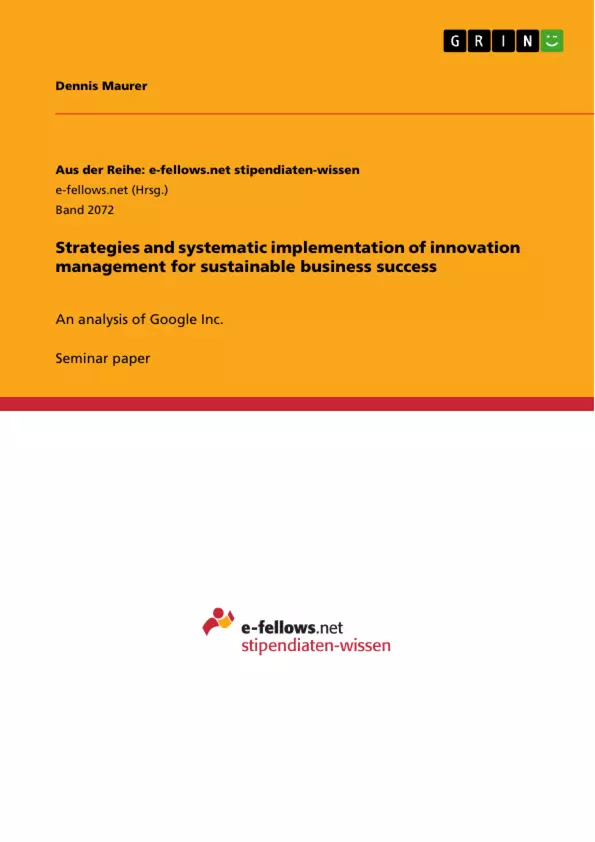Forming new businesses, entering new markets, and increasing organizational effectiveness, occurs through the innovation and transformation processes. Corporations must be able to adapt and evolve, if they wish to survive. The ability to innovate is a source of sustainable competitive advantage.
However, how is it possible for a company to breed innovation into the very bones of an organization, so that it becomes an ongoing, managed phenomenon? Is innovative thinking independent of external circumstances? Or, is there any method to its creativity? And what would an innovation model look like? The importance of innovation in regards to a businesses value is, without a doubt, the most meaningful and perhaps most essential aspect of a company. Innovation pays dividends for shareholders it drives growth and differentiation, motivates employees, opens new markets and captures customers’ attention, all while using much lower advertising budgets.
One company that has clearly done something right in the past is Google. This company is a symbol for integrative IT-infrastructures and restructuring business architecture through: experimentation, improvisation, analytical decision making, participative product development, and other noteworthy modes of innovation. It uses an evaluation of ideas with an admittedly chaotic ideation process and a set of accurate, data-driven methods. Google’s culture fascinates even the brightest technical expertise. It has developed or acquired an array of new offerings to augment the core search product. Its expansion, profitability, and shareholder equity, are at unmatched levels. It has been the designer, or a leading exponent of new paths to business and management innovation.
These are the main reasons why Google is a great allegory of innovation and a profound example of a successful integrated innovation management approach.
The purpose of this essay, based on Adapa Srinivasa Rao’s case study, “Corporate Entrepreneurship and Innovation at Google, Inc.” is to build a bridge between the company’s methods and the theoretical framework that abstractly enables and drives innovation in the corporate environment.
Inhaltsverzeichnis (Table of Contents)
- Introduction
- Delineation of concepts
- Innovation
- Corporate Entrepreneurship
- Invention
- Innovation strategies and its processes
- Why is an integrated innovation strategy necessary?
- Which elements are needed for innovation to occur?
- Which process steps need to be implemented to adapt a sustainable innovation strategy?
- Elements of the systematic implementation of the innovation model, based on Google Inc.
- Executive Champions – Long Term Approach – Consistency
- Operating Platform – Prosumer – Open Innovation
- Cooperation - Mashups – Infrastructure - Acquisition
- Innovation Culture – Employment Structure - Hard Work
- Critical review
Zielsetzung und Themenschwerpunkte (Objectives and Key Themes)
This essay aims to bridge the gap between Google's innovative methods and the theoretical framework that underpins corporate innovation. The study examines the differences between key terms, explores innovation strategies and their processes, and analyzes the systematic implementation of Google's innovation model. It concludes with a critical review.
- Defining and differentiating key concepts such as innovation, corporate entrepreneurship, and invention
- Analyzing the importance and necessity of integrated innovation strategies in the corporate environment
- Examining the elements and processes required for successful innovation
- Investigating the systematic implementation of an innovation model based on Google's practices
- Providing a critical review of the innovation model and its relevance to the broader corporate context
Zusammenfassung der Kapitel (Chapter Summaries)
- Introduction: This chapter introduces the essay's topic and sets the stage for the discussion on innovation in the corporate context. It highlights the disruptive impact of innovation on businesses and emphasizes the importance of understanding and implementing effective innovation strategies for organizational survival and growth. The chapter also introduces Google as a prominent example of a company that has successfully integrated innovation into its organizational culture and practices.
- Delineation of concepts: This chapter focuses on defining and differentiating key terms related to innovation, including innovation, corporate entrepreneurship, and invention. It explores the nuances of each term and emphasizes their distinct roles in driving corporate innovation. The chapter also examines various definitions of innovation and discusses the challenges of defining "newness" in the context of innovation.
- Innovation strategies and its processes: This chapter explores the concept of innovation strategies and their processes. It analyzes the reasons for implementing an integrated innovation strategy and examines the key elements necessary for successful innovation. The chapter also delves into the process steps required to adapt a sustainable innovation strategy within a corporate environment.
- Elements of the systematic implementation of the innovation model, based on Google Inc.: This chapter examines the systematic implementation of an innovation model based on Google's practices. It analyzes the key elements of Google's approach, including the role of executive champions, the importance of an open and collaborative operating platform, and the cultivation of an innovation culture. The chapter also highlights the importance of cooperation, infrastructure, and acquisition in driving innovation.
Schlüsselwörter (Keywords)
This essay focuses on the core concepts of innovation management, particularly exploring the intricacies of corporate entrepreneurship and innovation within a company like Google. Key themes include the definition and delineation of innovation, the importance of integrated innovation strategies, the elements and processes required for successful innovation, and the systematic implementation of an innovation model.
- Citar trabajo
- Dennis Maurer (Autor), 2016, Strategies and systematic implementation of innovation management for sustainable business success, Múnich, GRIN Verlag, https://www.grin.com/document/338066



